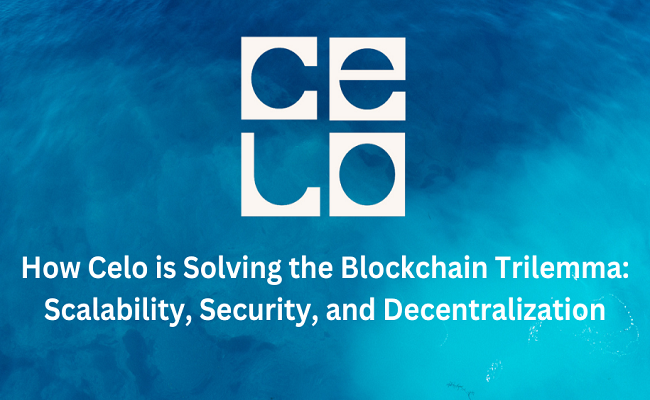Are you an investor exploring opportunities in blockchain technology? If so, gaining a comprehensive understanding of the blockchain trilemma is essential to making your decision fully secure. Blockchains contain three terms, such as Scalability, Security, and Decentralization, but it's difficult to achieve them all at the same level. This is known as the Blockchain Trilemma. This is where Celo comes in, with the potential to solve the Blockchain Trilemma by achieving these three properties at the same time.
In this blog post, you will get to know in detail about Celo node and how it is solving the blockchain Trilemma. Furthermore, exploring the advantages of Celo will provide insights into its significance for the future.
Celo: Solving the Blockchain Trilemma
Celo is an innovative blockchain platform and an Ethereum Virtual Machine (EVM) based that have the capacity of revolutionizing the world of finance. The main goal of Celo is to provide accessible financial tools and decentralized finance systems that cater to businesses of all sizes globally.
What truly sets Celo apart from other blochains is its mobile-first approach, which enables users to access and leverage financial services and tools right from their smartphones. By bringing up an Inclusive finance ecosystem, Celo is empowering individuals worldwide to seamlessly engage with global financial systems.
To solve the blockchain trilemma, Celo plays an essential role by providing blockchains with the capability to reach Scalability, Security, and Decentralization all together. Also, this mechanism enables nodes to achieve consensus without relying on the central authority.
Key elements: Celo Solving the Blockchain Trilemma
To address the blockchain trilemma, several critical factors come into play, including the three main pillars: scalability, security, and decentralization. But here are some key elements you need to know.
1. Proof-of-Stake (PoS) Consensus Mechanism
In order to maintain decentralization and security, a PoS mechanism is responsible for improving scalability. By allowing network participants to stake their cryptocurrency holdings, Celo ensures a more energy-efficient and sustainable blockchain platform.
2. Sharding
It is a layer 1 scalability method used by protocols to process transactions in parallel. In this, the role of Sharding is to split a set of transactions into smaller parts, AKA Shards. As a result, improving scalability by increasing the network's capacity to handle the higher number of transactions.
3. Governance
Users and stakeholders are involved in the Celo governance model, which promotes decentralization. Also, Celo holders play a crucial role in decision-making, and any modifications require their consensus.
The voting process for proposal approval follows a quorum threshold model. Celo aims to achieve a balanced approach to scalability, security, and decentralization by incorporating these essential elements.
Advantages of using Celo Network for dApps Development
Celo aims to address the blockchain trilemma, which refers to the challenge of achieving a balance between decentralization, security, and scalability in blockchain networks. The Celo network provides several advantages you can check here:
1. Cost-effective: Transaction fees are minimal when users perform specific tasks through the Celo blockchain, like running a smart contract or exchanging tokens. Usually, these fees are paid in CELO, the network's native cryptocurrency.
2. High Security: The thing that separates Celo from others is it provides high security. It reaches this by utilizing a proof-of-stake (PoS) consensus mechanism, which guarantees the network's security and integrity. Security plays a vital role in decentralized applications (dApps) as it directly contributes to gaining user trust.
3. Interoperability: Interoperability is a crucial concept that revolves around the seamless collaboration and data sharing between different systems or platforms. Interoperability plays an important role in enabling diverse blockchain networks to effectively communicate and exchange useful information with others.
The users of other blockchain networks, such as Ethereum or Bitcoin can use Decentralized apps that are built on the Celo platform.
4. Scalability: When it comes to dApps, Scalability is a crucial factor to consider. It refers to the dApps ability about how smoothly it handles a larger user base and huge volume of transactions without any delays or restrictions. If a dApp lacks scalability, it won't be able to meet the growing demands of users, leading to a poor user experience.
5. Easy to access: Celo designed to provide a user-friendly environment for developers for creating decentralized apps (dApps) on the platform. This is the thing that makes it easier and more efficient for developers to build dApps on the Celo platform without having to worry about unnecessary twists.
The Future of Celo Blockchain
The future of the Celo blockchain looks bright because it holds several potential developments. As a mobile-first platform, Celo aims to advance financial inclusion and empower individuals across the world with access to a secure and decentralized financial system. More than this, Celo is likely to continue expanding its ecosystem, attracting more developers and users to build innovative applications and services on the platform.
Additionally, Celo focuses on interoperability and cross-chain compatibility for collaborations and integrations with other blockchain networks, further enhancing its utility and adoption.
Final Thoughts
The blockchain platform Celo offers dApp developers numerous benefits, such as enhanced security, scalability, compatibility, and user-friendly implementation. In spite of that, it is crucial to consider potential challenges and drawbacks associated with adopting Celo, such as its slower adoption rate, complexity, and limitations on resources.
In the end, these factors basically depend on the requirements & goals of your dApp project and whether Celo is the most suitable choice for you or not.
